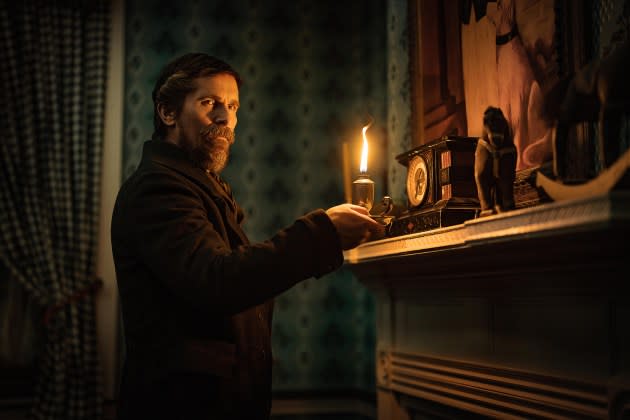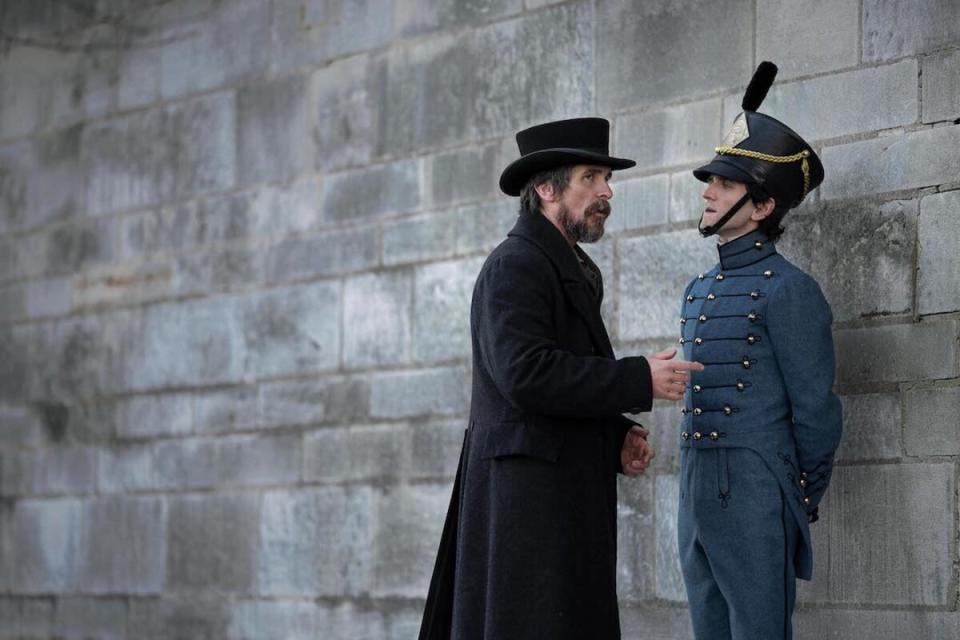‘The Pale Blue Eye’: Christian Bale and Edgar Allan Poe Solve Murders on Netflix
- Oops!Something went wrong.Please try again later.
- Oops!Something went wrong.Please try again later.
- Oops!Something went wrong.Please try again later.
- Oops!Something went wrong.Please try again later.

It’s 1830 on the snowy New York campus of the United States Military Academy and a young cadet has been found hanged. The coroner and others will eventually discover that the man’s heart has been stolen from his chest and a portion of a note, yet to be deciphered, has been hidden away, clutched in the dead man’s hardened grip. Not to worry: Christian Bale is on the case. The Pale Blue Eye stars Bale as Detective Augustus Landor, the kind of guy whose reputation (a dead wife, a missing daughter, alcoholism and great detective skills) precedes him like a stench. That means he’s perfect for the job: he has no one and nothing to lose. And he’s seen enough death, one presumes, that the spookiness of this endeavor, wherein the body count is sure to increase, probably won’t get to him.
The curveball that The Pale Blue Eye is going to throw Landor’s way isn’t so much due to its central mystery, even as this affair grows to involve satanic rituals, dead animals and emotionally skittish rich people. That stuff proves strangely uninteresting. Better is the cadet who finds Landor in a bar late one night, pulls him aside, and says, “The man you’re looking for is” — dramatic pause — “a poet.” How does this guy know? He’s a poet, too. He’s apparently Edgar Allan Poe.
More from Rolling Stone
Todd Haynes Believes He Got a Better Performance Out of Barbie
See Sofia Vergara Transform Into Notorious 'Cocaine Godmother' in 'Griselda' Trailer
That name doesn’t mean anything to Landor. But of course it means something to us. The Pale Blue Eye, written and directed by Scott Cooper and based on the 2003 Louis Bayard novel of the same name, is only ostensibly a movie about a mystery. Really, it’s a movie fixated on the spindly strangeness of the poet somewhat at its center, who’s only recruited into Landor’s company, at first, for the sake of his gothic instincts. Well, and maybe for the pleasure of his hifalutin drawl, the general Old South essence of his company, which stands out as exotic in the Hudson Valley and has accordingly made him a target among his peers. Poe, played by the adventurously odd Harry Melling, is a pained romantic, unique of visage, who talks too much, is excitable over poetry and is unexpectedly game for diving into the wreck of this story’s mystery.
The movie’s got a wide cast ranging from Timothy Spall and Gillian Anderson to Charlotte Gainsbourg, Toby Jones and Simon McBurney. But it’s Melling who stands out, because he’s supposed to. If he weren’t Edgar Allan Poe, he’d seem like a plant: a character whose strangeness is meant to attract our suspicion, to the benefit of the more obvious crook drifting somewhere in the shadows, pulling the strings. But because he’s Edgar Allan Poe, we know better: This is the guy who has yet to write (and recite, to a woman he loves) “The Raven” — which the movie gives him a chance to do. He’s a romantic, not a murderer. So it’s up to the rest of this dreary set to get our minds going, a job that they only barely get to do, in a movie that does not always seem confident in how and whether it aims to please us. The Pale Blue Eye is heavy, and not always to its advantage. Its glumness, meant to come off as a good-looking take on American gothic, gets in the way of its juicier, freakier bits. The offense is that it does so in service of a mystery that barely matters. Even the characters eventually feel like they’re just getting on with it.
Bale and Cooper work well enough together. The actor starred in Cooper’s Out of the Furnace (2013) and Hostiles (2017). The category is: “downtempo macho.” Cooper spent some years as a working actor before turning to screen directing and is — no surprise — good with actors. His directing debut was Crazy Heart, which nabbed Jeff Bridges a late-career Oscar, and his more recent work, like Hostiles, put the fine skills of actors like Rosamund Pike and Wes Studi on display. His movies are more coherent for their actorly musculature than for ins and outs and of the stories he tells, and The Pale Blue Eye is no different. The direction is for the most part sturdy and straight but for the sense that the actors were given good leeway to get weird. The movie is flush with minor curiosities, almost none of them related to the heart-thieving, satan-loving mystery of its central story and almost all of them due, instead, to the actors: from the weirdo audacity of Melling (who inspires even Bale’s Landor to step back and applaud), to the gruff insistence of Timothy Spall and the high grotesquerie of Gillian Anderson, who brings the same sense of quivering superiority to this role as she did to her take on Thatcher, for The Crown — only make it 19th century, and somehow more fucked up.

As a barmaid who is also Landor’s lover and confidant, Charlotte Gainsbourg’s Patsy may be the most normal person here. Unsurprisingly, she’s among the more underused members of the cast. It’s almost too bad — she’s too interesting, you verge on wanting her to insert herself into the story somehow, betray someone, liven things up. Pale Blue Eye, with its grim, snowy landscapes and shadowy interiors, can feel like a mood in search of a better story. For a movie full of secrets, there’s a deadness to much of it, as if there’s no use getting too excitable over a truth that will inevitably out itself eventually. Bale is the troubled soul holding the center, and the broader cast of West Point cadets — some of them clearly up to no good — make for ample contrast at the margins. It’s a troupe in service of a story that’s only barely satisfying when it finally decides to tie up loose ends. The real pleasure, it turns out, was always meant to be the weirdos we met along the way.
Which makes Bale a necessary counterpoint. He’s got the pain, but not the extremeness, at least not in this role. His wayward detective isn’t committed enough for this to be a job that gets him out of his slump, gives him a chance to redeem himself. This movie isn’t about that. He isn’t the detective as savior, nor is he really a man in need of saving, not exactly. Bale is somehow too even-keeled to dip firmly into an archetype. He approaches the role the way that Landor appears, at first, to approach this crime: Like a man on the job, maybe not much more. Being a genuine movie star, the kind of actor who’s worth watching even when the movie isn’t, Bale can do that and get away with it. What saves The Pale Blue Eye from itself is that it knows as much.
Best of Rolling Stone

